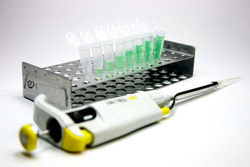Taking enzyme replacement therapy to the clinic
Alpha mannosidosis is a rare genetic disorder caused by lack of the enzyme alpha-mannosidase, which is required for breaking down sugars in the cell. The disease manifests progressively after birth with mental retardation, skeletal changes and recurrent infections. Currently, the most promising therapy for such lysosomal storage disorders is enzyme replacement therapy (ERT), where the enzyme is introduced into the patient through the bloodstream. The 'Towards the development of an effective enzyme replacement therapy for human alpha-mannosidosis' (HUE-MAN) project undertook multidisciplinary research to pave the way for successful ERT for human patients suffering from alpha-mannosidosis. Prior expertise of the groups on the mouse model of the disease allowed them to make significant advancements to establishing a treatment protocol. A major achievement was the development of a sensitive neuromotor performance test that conclusively defined the animal model as a valid pre-clinical evaluation step of alpha-mannosidosis. It also allowed for the monitoring of subtle neuromotor impairment. Additionally, the study unravelled a previously unrecognised role of epigenetic factors contributing to the disease. By examining the clinical and diagnostic characteristics of a plethora of patients, project members were able to define which parameters were critical for evaluating the efficacy of ERT. They also optimised the production of human recombinant lysosomal acid alpha-mannosidase (LAMAN) enzyme and tested the dose and mode of administration at the pre-clinical level. The efficacy of ERT in the animal model was confirmed through biochemical and histological analysis of various tissues. Overall, the HUE-MAN project conferred significant knowledge to the hallmarks of alpha-mannosidosis, set out the conditions for large-scale enzyme production and established pre-clinical and clinical therapy protocols. Most importantly, it provided a medicament for curing alpha-mannosidosis.







